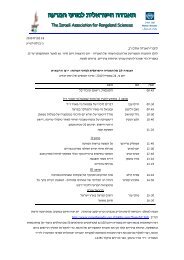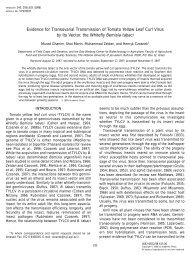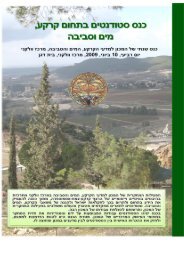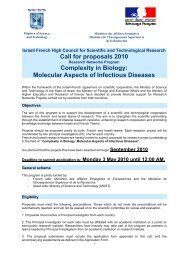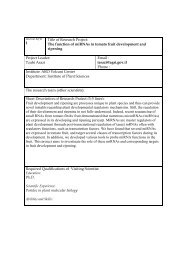Novel micro-RNAs and intermediates of micro-RNA biogenesis from ...
Novel micro-RNAs and intermediates of micro-RNA biogenesis from ...
Novel micro-RNAs and intermediates of micro-RNA biogenesis from ...
You also want an ePaper? Increase the reach of your titles
YUMPU automatically turns print PDFs into web optimized ePapers that Google loves.
The Plant Journal (2006)doi: 10.1111/j.1365-313X.2006.02768.x<strong>Novel</strong> <strong>micro</strong>-<strong><strong>RNA</strong>s</strong> <strong>and</strong> <strong>intermediates</strong> <strong>of</strong> <strong>micro</strong>-<strong>RNA</strong><strong>biogenesis</strong> <strong>from</strong> mossMali Talmor-Neiman 1 , Ran Stav 1 , Wolfgang Frank 2 , Bjoern Voss 2 <strong>and</strong> Tzahi Arazi 1,*1 Department <strong>of</strong> Ornamental Horticulture, Agricultural Research Organization, The Volcani Center, PO Box 6, Bet Dagan 50250,Israel, <strong>and</strong>2 Plant Biotechnology, University <strong>of</strong> Freiburg, Schaenzlestr. 179104, Freiburg, GermanyReceived 18 January 2006; revised 2 March 2006; accepted 3 March 2006.* For correspondence (fax þ972 3 9669583; e-mail tarazi@volcani.agri.gov.il).SummaryMicro-<strong><strong>RNA</strong>s</strong> (mi<strong><strong>RNA</strong>s</strong>) are one class <strong>of</strong> small non-coding <strong><strong>RNA</strong>s</strong> that have important regulatory roles in higherplants. Much less is known about their prevalence <strong>and</strong> function in lower l<strong>and</strong> plants. Previously we cloned 100non-structural small <strong><strong>RNA</strong>s</strong> <strong>from</strong> the moss Physcomitrella patens but could annotate only 11 as mi<strong><strong>RNA</strong>s</strong>. Toidentify additional moss mi<strong><strong>RNA</strong>s</strong> among cloned small <strong><strong>RNA</strong>s</strong> we have analyzed their genomic sequences for acharacteristic mi<strong>RNA</strong> precursor-like structure. This analysis revealed 19 new moss mi<strong><strong>RNA</strong>s</strong> that are predictedto be encoded by 22 putative foldbacks. Northern blot analysis confirmed the expression <strong>of</strong> 14 new mi<strong>RNA</strong>representatives. Half <strong>of</strong> these were gametophore specific, the rest were detected at low levels in theprotonema. We predicted 12 genes as targets <strong>of</strong> nine new mi<strong><strong>RNA</strong>s</strong>. Three <strong>of</strong> these show homology totranscription factors <strong>and</strong> the others appear to play roles in diverse physiological processes including light <strong>and</strong>cytokine signaling, which have not to date been shown to be regulated by a mi<strong>RNA</strong> in flowering plants. Fourtarget genes, which show homology to ATN1-like protein kinase, NAC transcription factors <strong>and</strong> a cytokininreceptor, have been validated by mi<strong>RNA</strong>-mediated m<strong>RNA</strong> cleavage. In addition, our analysis revealed thatseven small <strong><strong>RNA</strong>s</strong> represent mi<strong>RNA</strong>* <strong>and</strong> three represent <strong>intermediates</strong> <strong>of</strong> pre-mi<strong>RNA</strong> processing, providingevidence for specific DICER-like cleavage steps during mi<strong>RNA</strong> <strong>biogenesis</strong> in moss. Our findings suggest thatmi<strong><strong>RNA</strong>s</strong> are common in mosses <strong>and</strong> set the stage for the elucidation <strong>of</strong> their varied biological functions.Keywords: Physcomitrella patens, moss, mi<strong>RNA</strong>, <strong>biogenesis</strong>, cytokinin, phytochrome.IntroductionMicro-<strong><strong>RNA</strong>s</strong> (mi<strong><strong>RNA</strong>s</strong>) form an abundant class <strong>of</strong> 21–24-nucleotide small <strong><strong>RNA</strong>s</strong> that are common to diverse species<strong>of</strong> multicellular life. In flowering plants they are major regulators<strong>of</strong> development, but have also been predicted, orconfirmed, to regulate other processes such as signaltransduction, protein degradation <strong>and</strong> responses to environmentalstress <strong>and</strong> pathogen invasion (reviewed byZhang et al., 2006).The <strong>biogenesis</strong> <strong>of</strong> an mi<strong>RNA</strong> in plants seems to be amultistep process that begins with the transcription <strong>of</strong> anMI<strong>RNA</strong> gene into a large capped <strong>and</strong> polyadenylatedprimary transcript (pri-mi<strong>RNA</strong>) that contains an imperfectfoldback structure (Chen, 2005; Xie et al., 2005). It has beendemonstrated that mi<strong><strong>RNA</strong>s</strong> in many higher plants requireDicer-Like1 (DCL1) (Park et al., 2002). It has been establishedthat pri-miR163, pri-miR164b <strong>and</strong> pri-miR166a are cleavedby DCL1 to a stem-loop precursor or pre-mi<strong>RNA</strong> (Kurihara<strong>and</strong> Watanabe, 2004; Kurihara et al., 2006). This step isbelieved to occur in the nucleus (Papp et al., 2003; Park et al.,2005). Pre-miR163 is then processed to short pre-miR163(Kurihara <strong>and</strong> Watanabe, 2004). Pre-miR-164b <strong>and</strong> -166a <strong>and</strong>short pre-miR163 are further processed by DCL1, tomi<strong>RNA</strong>:mi<strong>RNA</strong>* <strong>and</strong> a loop remnant (Kurihara <strong>and</strong> Watanabe,2004; Kurihara et al., 2006). The mi<strong>RNA</strong>:mi<strong>RNA</strong>* duplexcomprises a mature mi<strong>RNA</strong> <strong>and</strong> a similarly sized complementaryfragment called mi<strong>RNA</strong>*; these are <strong>of</strong>fset by twonucleotides because <strong>of</strong> the staggered cuts <strong>of</strong> DCL1 (Elbashiret al., 2001). After its release <strong>from</strong> the pre-mi<strong>RNA</strong>, themi<strong>RNA</strong>:mi<strong>RNA</strong>* duplex is translocated into the cytoplasmby HASTY, the plant exportin-5 homolog (Park et al., 2005).In the cytoplasm, mature mi<strong><strong>RNA</strong>s</strong> are selectively loaded intothe <strong>RNA</strong>-induced silencing complex (RISC) <strong>and</strong> primarilyª 2006 The Authors 1Journal compilation ª 2006 Blackwell Publishing Ltd
2 Mali Talmor-Neiman et al.guide the cleavage <strong>of</strong> target m<strong><strong>RNA</strong>s</strong> (Llave et al., 2002;Palatnik et al., 2003; Schwab et al., 2005; Tang et al., 2003).To date, 872 mi<strong><strong>RNA</strong>s</strong> belonging to 42 families have beenidentified in 71 plant species, most <strong>of</strong> which are floweringplants (Zhang et al., 2006); the sequence data are accessibleat the mi<strong>RNA</strong> registry (http://<strong>micro</strong>rna.sanger.ac.uk/sequences/index.shtml). These mi<strong><strong>RNA</strong>s</strong> provided importantinsights into the functions <strong>of</strong> mi<strong><strong>RNA</strong>s</strong> in l<strong>and</strong> plants. Still, tobe able to underst<strong>and</strong> the extent <strong>of</strong> mi<strong>RNA</strong> regulationthroughout the l<strong>and</strong> plant clade, additional information onmi<strong><strong>RNA</strong>s</strong> <strong>and</strong> their <strong>biogenesis</strong> in more diverse l<strong>and</strong> plants isneeded. Mosses are one <strong>of</strong> the oldest groups <strong>of</strong> l<strong>and</strong> plantsamong the Earth’s flora. They originated around 350 millionyears ago <strong>and</strong> diverged <strong>from</strong> flowering plants more than 400million years ago, although subsequently, as indicated bycomparison with the fossil record, they have evolved little(Cove et al., 1997). Information on the molecular biology <strong>of</strong>mosses has come mainly <strong>from</strong> studies <strong>of</strong> the model monoeciousmoss Physcomitrella patens (Cove, 2000) in whichefficient homologous recombination allows targeted genedisruption for the study <strong>of</strong> individual gene function (Schaefer<strong>and</strong> Zryd, 1997). Although numerous small <strong><strong>RNA</strong>s</strong> havebeen cloned <strong>from</strong> the mosses Polytrichum juniperinum(Axtell <strong>and</strong> Bartel, 2005) <strong>and</strong> P. patens (Arazi et al., 2005),only 11 were identified as authentic mi<strong><strong>RNA</strong>s</strong> in P. patens onthe basis <strong>of</strong> their homology to higher plant mi<strong><strong>RNA</strong>s</strong> (PpmiR319a,Pp-miR319b, Pp-miR319c, miR156, miR390 <strong>and</strong>miR535), their abundance in the library, expression orputative hairpin precursors (miR534, miR538, miR533a,miR536 <strong>and</strong> miR537) (Arazi et al., 2005). In addition, ahomolog <strong>of</strong> miR160 was identified in Polytrichum juniperinum(Axtell <strong>and</strong> Bartel, 2005).In the present study, we describe the identification <strong>of</strong> 19new P. patens mi<strong><strong>RNA</strong>s</strong> <strong>from</strong> cloned small <strong><strong>RNA</strong>s</strong> followingthe analysis <strong>of</strong> the corresponding raw genomic sequence.Target prediction <strong>and</strong> validation suggest that these mi<strong><strong>RNA</strong>s</strong>are involved in various physiological processes. In addition,we identified several mi<strong>RNA</strong>* <strong>and</strong> <strong>intermediates</strong> <strong>of</strong> premi<strong>RNA</strong>processing, shedding light on mi<strong>RNA</strong> <strong>biogenesis</strong> inlower l<strong>and</strong> plants.released including 7 341 086 raw sequences (http://www.ncbi.nlm.nih.gov/Traces/trace.cgi?). Therefore, toidentify novel mi<strong><strong>RNA</strong>s</strong>, previously unannotated small <strong><strong>RNA</strong>s</strong>were analyzed as illustrated in Figure 1. Our analysis mappeda total <strong>of</strong> 29 small <strong><strong>RNA</strong>s</strong> to 27 pre-mi<strong>RNA</strong>-like foldbackstructures (Figure 2). We found that Pp_34, Pp_103, Pp_108<strong>and</strong> Pp_111 were complementary with two nucleotides <strong>of</strong>fsetto miR533a, miR534, miR537 <strong>and</strong> Pp-miR319b, respectively.Moreover, their cloning frequency was much lowerthan the corresponding mi<strong>RNA</strong> (Table S1 <strong>and</strong> Table S1 inArazi et al., 2005), suggesting that each represents a mi-<strong>RNA</strong>* (Figure 2, gray). Another small <strong>RNA</strong>, Pp_76, wascomplementary to Pp_116 with two nucleotides <strong>of</strong>fset (Figure2, Pp-MIR1222, gray). Because only Pp_116 could bedetected by Northern blotting we concluded that Pp_76 isthe mi<strong>RNA</strong>* <strong>of</strong> Pp_116, which by itself represents a newP. patens mi<strong>RNA</strong> (miR1222). We also found that small <strong>RNA</strong>Pp_29 corresponded to a 3¢ arm <strong>of</strong> a foldback (Figure 2, Pp-MIR390c, gray) with two nucleotides <strong>of</strong>fset to a Pp-miR390acomplementary sequence. As Pp-MIR390c was not 100%identical to Pp-miR390a, we suggest that Pp_29 is the mi-<strong>RNA</strong>* <strong>of</strong> an as yet un-cloned member <strong>of</strong> the miR390 family(Pp_miR390b) in P. patens that might be shorter thanmiR390 by one nucleotide at its 5¢ end (Table 1).Three foldbacks (Pp-MIR1219a, Pp-MIR1219b <strong>and</strong> Pp-MIR1219c) are predicted to encode Pp_106a <strong>and</strong> one (Pp-MIR1219d) is predicted to encode an as yet uncloned familymember <strong>of</strong> Pp_106a (Pp_106b), which is different by onenucleotide at its 5¢ end (Table 1). Moreover, folding analysisindicated that Pp_124 was the mi<strong>RNA</strong>* <strong>of</strong> Pp_106a, whichvalidated its identity as an authentic mi<strong>RNA</strong> (miR1219a;Figure 2, Pp-MIR1219a, gray). Interestingly, putative precursors<strong>of</strong> miR1219a <strong>and</strong> miR1219b were found to be organizedin two clusters in which precursor pairs are located withinNon-annotatedcloned small <strong><strong>RNA</strong>s</strong><strong>from</strong> P. patens protonema(113)ResultsFolding analysis <strong>of</strong> P. patens raw genomic sequencesidentifies novel mi<strong><strong>RNA</strong>s</strong>Previously we cloned a set <strong>of</strong> 100 non-structural small <strong><strong>RNA</strong>s</strong><strong>from</strong> P. patens protonema (Arazi et al., 2005). Furthersequencing <strong>of</strong> that library identified 24 additional distinctsmall <strong>RNA</strong> sequences (Table S1). Nevertheless, the majority<strong>of</strong> cloned small <strong><strong>RNA</strong>s</strong> could not be analyzed for the stem<strong>and</strong>-loopgene structure indicative <strong>of</strong> a mi<strong>RNA</strong> because themoss genomic sequence was not available. However, ashotgun genome sequence <strong>of</strong> P. patens was recently-Identity to genome sequence (90)-Foldback prediction <strong>and</strong> stability (31)-Pre-mi<strong>RNA</strong> consensus properties (29)Figure 1. Flowchart for the identification <strong>of</strong> c<strong>and</strong>idate mi<strong><strong>RNA</strong>s</strong> in clonedsmall <strong><strong>RNA</strong>s</strong>.The number <strong>of</strong> small <strong><strong>RNA</strong>s</strong> passing each stage is shown in parentheses.Identity to a genome sequence was determined by BLASTN against theP. patens genome database (http://moss.nibb.ac.jp/blast/blast.html). Redundantidentical genomic sequences were then clustered using the CLUSTALWsequence alignment tool (Thompson et al., 1994). Foldback prediction <strong>and</strong>stability was done by MFOLD (Zuker, 2003) <strong>and</strong> RANDFOLD s<strong>of</strong>tware (Bonnetet al., 2004b), respectively. The consensus properties <strong>of</strong> plant pre-mi<strong><strong>RNA</strong>s</strong>were as formulated previously by Xie et al. (2005).ª 2006 The AuthorsJournal compilation ª 2006 Blackwell Publishing Ltd, The Plant Journal, (2006), doi: 10.1111/j.1365-313X.2006.02768.x
<strong>Novel</strong> mi<strong><strong>RNA</strong>s</strong> <strong>and</strong> mi<strong>RNA</strong> <strong>biogenesis</strong> <strong>intermediates</strong> in moss 3Pp-MIR319d| U UU U UG A U U G AC A UUC C C U AC5' CAGCG GGAGCU CUUCGGUCCAA AG GCUGAGUCG AGGUUG GC GCU CCG UCA AC CGG UUCC UA CCA \3' GUCGC CCUCGA GAAGUCAGGUU UC CGAUUCGGC UCUAAC UG CGA GGC AGU UG GCC AAGG AU GGU C^ C GG C UA C U U G AU C UAA U U - CCPp-MIR533a/Pp_109| GC AC AGA CUUGU CC5' AUGGGGAGCUG CAGGCUGUGAGGG GGAGC GUUGG GGCU U3' UGCCUCUCGAC GUCUGACACUCCU CUUCG CGACC CCGG U^ AC C- A-- UCCC- UGPp-MIR534| C UGU G -- U UG A- .-AA A U U --- GA UU5' AUAUG AUGCAACU GUGGACA ACUGA CUAGUC AG GUGU GUGG AGUAUU GU GGU GAUG CAC UGUUG \3' UAUAC UACGUUGA UACCUGU UGACU GAUCAG UC UACA CACC UCAUAA CG UCG CUGC GUG ACAAC U--^ A CGU A UA C GU CC (35nt side loop) - - - UCA A- GUPp-MIR537a| - A A G CGAG A AU- U .-GC AUAA U5' GUUGUCG UCAUAU UGG CUGUAGAAACACCU AAG UGAGG CC CCGAU CUA CAUGGAAACAG GAGCUCA G3' CGAUAGU AGUAUA AUC GACAUCUUUGUGGA UUC ACUUC GG GGCUA GAU GUGUCUUUGUC CUUGGGU U^ U C G G UCAA - AUU C \ -- ---- CPp-MIR1210| A C U C A- A U G5' AGGGC GUUG UUUUUCCUCUCCC CAAAGGCUUC AAC UG UG GC U3' UUCCG UAAC AAGAAGGAGAGGG GUUUCCGAAG UUG AC AC CG A^ C A U A CA - - APp-MIR1211U| -- GU AA GGGUG C5' UACAUGAU U C CAGGGAGGGAUGGUUAUGCAAGA CAAGAGGUGG A3' AUGUAUUG A G GUCCUUCUCUGCCAGUACGUUCU GUUCUCUACU GA^ AG UG AC ACGAA A784207533| AG AG - C A A AAACU CA C C C A G AAA5' GGUAAA G UC UG AGAA UC UGGGGGGG GG CUG CUGGCUCCCUGUAUG CA UUGCG AUUUUG CA \3' CCAUUU C AG AC UCUU AG GCCCUUCU CC GAC GACUGAGGGACAUAC GU GAUGC UGGGAC GU C^ CU GA U - - - ACGUU A- A C C A G GUUPp-MIR1212G| UG G C C G AU C G GC5' UA AGGA UUGCAU CU UGCUGU CCCAC GCGU GU GC \3' AU UCCU GGCGUA GA ACGACA GGGUG CGCG CG CG G-^ GU A A U - -- C G GU717625569A| C U C CGG C AG5' CUG CUGGCUCCCUG AUGCCA CUG GGCUUG CAA \3' GAC GACCGAGGGAC UACGGU GAU UCGAGC GUU UA^ A C C ACG U AGPp-MIR1213| - UGGUU U G U UCA A UC-- U C UGA UUA5' GAGUCU CUAA ACAGGG GUUC UUU UCUCCC AAGGCUUCCAACA CAG GGAAU AA UC UGCGGCCA \3' UUCGGA GGUU UGUUCC CAAG AAG AGAGGG UUCCGAAGGUUGU GUC UCUUA UU AG ACGUUGGU U^ A ----- - A C UGC C UUGA - A UG- CACPp-MIR1214U|U GUUU A UC CCA UU5' G GGUUGG UCU CUAUGAGAA UCGCGG AGGUGGUU G3' C CCGAUC AGA GAUACUCUU AGCGUC UUUACCAG GA^C AAGU C UU --- CAPp-MIR1215| A U C- U A G .-CAACUUGA - AUU5' CGUG AGG ACUGGAG UCAU GC AAACUGUAUAC AUCCUUU ACA GC C3' GUAC UCC UGACCUC GGUG CG UUUGACAUAUG UAGGAGA UGU CG G^ A C AA U C G \ -------- U AAA(11 nt side loop)ª 2006 The AuthorsJournal compilation ª 2006 Blackwell Publishing Ltd, The Plant Journal, (2006), doi: 10.1111/j.1365-313X.2006.02768.x
<strong>Novel</strong> mi<strong><strong>RNA</strong>s</strong> <strong>and</strong> mi<strong>RNA</strong> <strong>biogenesis</strong> <strong>intermediates</strong> in moss 5Pp-MIR1222| ACA C ----- CU A U AA GCU5' CACG UAG UGGU UGUUGUGGGCAUU UGUGCUAGU AACUCCUUCA GCAG GUGC \3' GUGC AUU GCCA ACAACACCCGUAA AUAUGGUUA UUGAGGAAGU CGUC CACG U^ A-- A GUAGU AU C U -- AUCPp-MIR1223| - CAA C - ---- UAGUA GC5' AGACUAGAGG GUCAG GGGUGUGUGACUCUAUAAUC AA GCU GUGC GAUC U3' UCUGAUCUUC CAGUC UCCACAUACUGAGAUGUUAG UU CGA CACG CUAG U^ A ACC C A ACCA UGAAG AAPp-MIR390c| UUA A G CAUCUCA UUU - UU A GG5' GGUAUAA CAG GCUCAGGA GGAUAGCGCC GUC UUUAGC AUCCAA GAA UG \3' CCAUGUU GUU CGAGUCUU CCUGUCGCGG CGG AGAUCG UAGGUU CUU AC U^ UAC A A UACAAAG C-- A UC - AAFigure 2. Predicted foldback structures <strong>of</strong> putative mi<strong>RNA</strong> precursors.The mi<strong>RNA</strong> sequences are underlined. Predicted mi<strong><strong>RNA</strong>s</strong> are italicized. Cloned mi<strong>RNA</strong>* is gray shadowed. The actual size <strong>of</strong> each putative precursor was notidentified experimentally <strong>and</strong> may be slightly shorter or longer than represented.Table 1 <strong>Novel</strong> P. patens c<strong>and</strong>idate mi<strong><strong>RNA</strong>s</strong>SmallFoldback arm/<strong>RNA</strong> Length Sequence a Trace/MIR gene b nucleotides c<strong>RNA</strong>blot dmi<strong>RNA</strong>*P. patensESTHomology ePp_13 21 AGAAGCCUUUGUGGGAGAGGA 686715266/MIR1210 3¢/99 d Pj_10Pp_18 21 AGGGAGGGAUGGUUAUGCAAG 713855171/MIR1211 5¢/112 dPp_26 21 CCAUACAGGGAGUCAGACAGA 784207533/– 3¢/162 ndPp_31 21 CGUGGGACAGCAUAGAAUGCG 713871562/MIR1212 3¢/89 d Pj_170Pp_44 21 GCAUCCAGGGAGCCAGACAGA 717625569/– 3¢/85 ndPp_53 21 GUUGGAAGCCUUCGUGGGAGA 828270278/MIR1213 3¢/164 d Pj_201Pp_55 21 UACUAUGAGAAUCUCGCGGCC 815622998/MIR1214 5¢/93 dPp_63 21 UCAUUGCAAAACUGUAUACGA 831635002/MIR1215 5¢/127 dPp_75 21 UGAUGGUGAUGCGCUUGUAUC 774450283/MIR1216 5¢/158 dPp_101 21 AAUUUGAAGCAUGAUGUCAAG 830441252/MIR1217 3¢/111 d contig14150Pp_104 21 CCUUAGAGUCGUAGGCCUCUG 774610216/MIR1218 5¢/138 d pph34n07Pp_106a 21 CUUCCUGCCUCUCACUAGCUU 755786909.1/MIR1219a 5¢/135 d Pp_124755786909.2/MIR1219b 5¢/78824631517.2/MIR1219c 5¢/152Pp_106b 21 uuuccugccucucacuagcuu 824631517.1/MIR1219d 5¢/136 nt Pp_106aPp_107 21 GAAGAUAGAGGAGUUCAAGAA 784303541/MIR1220a 3¢/205 d863100468/MIR1220b 3¢/205Pp_109 22 GAGCUGGCCAGGCUGUGAGGGA 755813659/MIR533a 5¢/108 nt miR533Pp_110 21 GAGCUGUCCAGGCUGUGAGGG 835903236/MIR533b 5¢/125 nt miR533Pp_113 22 UGACAACGAGAGAGAGCACGCC 756805268/MIR535d 5¢/85 nt miR535Pp_114 21 UGGAUGGUGUGCAGGGUCAAA 759445026/MIR1221 5¢/177 dPp_116 21 UUGAAGGAGUUCAUUGGUAUA 759457106/MIR1222 3¢/130 d Pp_76 Pj_62Pp_117 21 UUGUAGAGUCAUACACCUCCA 831697289/MIR1223 3¢/126 dPp_miR390b 20 agcucaggagggauagcgcc 784214430/MIR390c 5¢/135 nt Pp_29 miR390a Lower case nucleotides are predicted. The precise ends <strong>of</strong> the mi<strong>RNA</strong> have not yet been determined.b One representative trace for each independent gene is shown. ()) identity as a mi<strong>RNA</strong> was not confirmed.c Predicted; the actual size <strong>of</strong> each precursor has not been identified experimentally <strong>and</strong> may be slightly shorter or longer than represented.d nd, not detected; d, detected; nt, not tested because <strong>of</strong> sequence homology.e Pj, Polytrichum juniperinum.approximately 200 bp <strong>of</strong> each other (Figure 3), suggestingthat they belong to the same pri-mi<strong>RNA</strong>. In contrast toanimal pre-mi<strong><strong>RNA</strong>s</strong>, which are commonly clustered, thisarrangement is quite rare in flowering plants <strong>and</strong> has beenreported to date only for miR399 (Sunkar <strong>and</strong> Zhu, 2004) <strong>and</strong>rice miR395 (Oryza sativa; Jones-Rhoades <strong>and</strong> Bartel, 2004).Sequence alignments <strong>of</strong> newly identified c<strong>and</strong>idatemi<strong><strong>RNA</strong>s</strong> to known P. patens mi<strong><strong>RNA</strong>s</strong> (Arazi et al., 2005)<strong>and</strong> to small <strong><strong>RNA</strong>s</strong> <strong>from</strong> the moss Polytrichum juniperinum(Axtell <strong>and</strong> Bartel, 2005) suggest that Pp_109(miR533b) <strong>and</strong> Pp_110 (miR533c) are members <strong>of</strong> themiR533 family (Figure 4a) <strong>and</strong> Pp_113 (miR535b) is aª 2006 The AuthorsJournal compilation ª 2006 Blackwell Publishing Ltd, The Plant Journal, (2006), doi: 10.1111/j.1365-313X.2006.02768.x
6 Mali Talmor-Neiman et al.Figure 3. Predicted secondary structures <strong>of</strong>miR1219a polycistronic pri-mi<strong>RNA</strong>. miR1219a<strong>and</strong> miR1219b sequences are highlighted in gray<strong>and</strong> light gray respectively.member <strong>of</strong> the miR535 family (Figure 3b). However,Pp-MIR533a that is predicted to encode the 21-nucleotidemiR533a is also predicted to encode the 22-nucleotidemiR533b (Figure 2), <strong>and</strong> thus we cannot exclude thepossibility that miR533b is a processing variant <strong>of</strong>miR533a. In addition, Pp_13 <strong>and</strong> Pp_31 were found to beidentical to Pj_10 <strong>and</strong> Pj_170, respectively, <strong>and</strong> Pp_53 <strong>and</strong>miR1222 had 90.5% identity to Pj_201 (Figure 4c) <strong>and</strong> Pj_62(Figure 4d), respectively, raising the possibility that thesesmall <strong><strong>RNA</strong>s</strong> represent conserved mi<strong><strong>RNA</strong>s</strong> in mosses(Table 1).As pri-mi<strong><strong>RNA</strong>s</strong> are capped <strong>and</strong> polyadenylated noncoding<strong><strong>RNA</strong>s</strong>, such pri-mi<strong><strong>RNA</strong>s</strong> would appear as non-codingexpressed sequence tags (ESTs) (Zhang et al., 2005). ABLASTN search against the P. patens EST database (http://moss.nibb.ac.jp/blast/blast.html) revealed that Pp-MIR1217<strong>and</strong> Pp-MIR1218 were identical to the non-coding ESTcontigs 14150 <strong>and</strong> pph34n07, respectively. These findingssupport the characterization <strong>of</strong> Pp_101 <strong>and</strong> Pp_104 asmi<strong><strong>RNA</strong>s</strong> (miR1217 <strong>and</strong> miR1218, respectively) that areencoded in capped <strong>and</strong> polyadenylated pri-mi<strong>RNA</strong>. Thus,the analysis presented so far provides supporting evidencefor the identity <strong>of</strong> 10 new mi<strong><strong>RNA</strong>s</strong> (miR1210, miR1212,miR1213, miR1217, miR1218, miR1219a, miR533b, miR533c,miR535b <strong>and</strong> miR1222), two predicted mi<strong><strong>RNA</strong>s</strong> (miR1219b<strong>and</strong> Pp_miR390b) <strong>and</strong> seven mi<strong>RNA</strong>* in moss. The rest<strong>of</strong> the small <strong><strong>RNA</strong>s</strong> (Pp_18/miR1211, Pp_26, Pp_44, Pp_55/miR1214, Pp_63/miR1215, Pp_75/miR1216, Pp_107/miR1220,Pp_114/miR1221 <strong>and</strong> Pp_117/miR1223), which correspondedto a predicted pre-mi<strong>RNA</strong> foldback structure (except Pp_82,Pp_112 <strong>and</strong> Pp_115), were characterized as c<strong>and</strong>idatemi<strong><strong>RNA</strong>s</strong> (Table 1).ª 2006 The AuthorsJournal compilation ª 2006 Blackwell Publishing Ltd, The Plant Journal, (2006), doi: 10.1111/j.1365-313X.2006.02768.x
<strong>Novel</strong> mi<strong><strong>RNA</strong>s</strong> <strong>and</strong> mi<strong>RNA</strong> <strong>biogenesis</strong> <strong>intermediates</strong> in moss 7(a)(b)(c)(d)Figure 4. Homology <strong>of</strong> newly identified mi<strong><strong>RNA</strong>s</strong> to known mi<strong><strong>RNA</strong>s</strong> <strong>and</strong>Polytrichum juniperinum cloned small <strong><strong>RNA</strong>s</strong>.(a–d) Sequences were aligned with the CLUSTALW program. Identical <strong>and</strong>conserved nucleotides are labeled in upper case letters. Lower case lettersrepresent changes in nucleotide sequences in some group members. Pj,Polytrichum juniperinum.Several cloned small <strong><strong>RNA</strong>s</strong> represent <strong>intermediates</strong> <strong>of</strong>pre-mi<strong>RNA</strong> processingOur folding analysis revealed that Pp_82 matched the root <strong>of</strong>the putative miR1219a precursor Pp-MIR1219a just threenucleotides upstream <strong>of</strong> miR1219a (Figure 5a, underlined).In addition, Pp_112 <strong>and</strong> Pp_115 were found to be identical tothe putative Pp-miR319b precursor Pp-MIR319d. They matcheda region in its elongated stem between PpmiR319b:Pp-miR319b*<strong>and</strong> the loop structure (Figure 5b,single <strong>and</strong> double underlined). Moreover, Pp_112 <strong>and</strong>Pp_115 are predicted to complement each other with twonucleotides <strong>of</strong>fset reminiscent <strong>of</strong> a mi<strong>RNA</strong>:mi<strong>RNA</strong>* duplex(Figure 5b), suggesting that their <strong>biogenesis</strong> is mediated bya DICER-like protein.Expression analysis <strong>of</strong> newly identified mi<strong><strong>RNA</strong>s</strong>The mi<strong><strong>RNA</strong>s</strong> that we previously characterized in moss wererelatively abundant in the protonema small <strong>RNA</strong> library(Arazi et al., 2005). Conversely, 15 out <strong>of</strong> the 19 new c<strong>and</strong>idatemi<strong><strong>RNA</strong>s</strong> were identified only once in the small <strong>RNA</strong>library, implying that their abundance in the protonemashould be relatively low. Consistent with that, their expressionin the moss gametophyte could be detected by Northernblots only on 100 lg samples <strong>of</strong> total <strong>RNA</strong> extracted<strong>from</strong> 8–10-day-old protonema <strong>and</strong> 45-day-old gametophoreor in a low-molecular-weight <strong>RNA</strong> fraction isolated <strong>from</strong>500 lg <strong>of</strong> protonema total <strong>RNA</strong>. Northern blots confirmedthat 14 out <strong>of</strong> 16 representative mi<strong><strong>RNA</strong>s</strong> tested were stablyexpressed in the gametophyte, which reinforced theiridentity as authentic mi<strong><strong>RNA</strong>s</strong> (Figure 6). miR1210, miR1213,miR1214, miR1218, miR1221, miR1222 <strong>and</strong> miR1223 weredetected almost exclusively in mature gametophores <strong>and</strong>were barely detectable in the protonema (Figure 6, lane G),consistent with their low abundance in the protonema library.miR1211, miR1212, miR1215, miR1216, miR1217,miR1219a <strong>and</strong> miR1220 could be detected only in concentratedprotonemal low-molecular-weight <strong>RNA</strong> (Figure 6,lane C), suggesting that they are expressed at very lowsteady state levels in the gametophyte. This may be becausethey are expressed only under particular growth conditions,in specific cell types or mainly in a developmental stage suchas the sporophyte that was not tested in this study. Multipleb<strong>and</strong> signals <strong>of</strong> sizes bigger than 21 nucleotides weredetected with probes complementary to Pp_26 <strong>and</strong> Pp_44(data not shown), <strong>and</strong> therefore the identity <strong>of</strong> these c<strong>and</strong>idatesas mi<strong><strong>RNA</strong>s</strong> could not be confirmed.Predicted targets <strong>of</strong> newly identified mi<strong><strong>RNA</strong>s</strong>To identify the potential targets <strong>of</strong> newly identified mi<strong><strong>RNA</strong>s</strong>,we first used PATSCAN (Dsouza et al., 1997) to search theP. patens public EST database for m<strong><strong>RNA</strong>s</strong> that were(a)(b)Figure 5. Physcomitrella patens cloned small <strong><strong>RNA</strong>s</strong> that represent <strong>intermediates</strong> <strong>of</strong> pre-mi<strong>RNA</strong> processing.(a) Sequence <strong>of</strong> Pp-MIR1219a stem <strong>and</strong> loop. The sequences <strong>of</strong> miR1219a, miR1219a* <strong>and</strong> Pp_82 are bold-face, gray boxed <strong>and</strong> underlined, respectively.(b) Sequence <strong>of</strong> Pp-MIR319d stem <strong>and</strong> loop. The sequences <strong>of</strong> Pp-miR319b, Pp-miR319b*, Pp_112 <strong>and</strong> Pp_115 are bold-face, gray boxed, underlined <strong>and</strong> doubleunderlined, respectively.ª 2006 The AuthorsJournal compilation ª 2006 Blackwell Publishing Ltd, The Plant Journal, (2006), doi: 10.1111/j.1365-313X.2006.02768.x
8 Mali Talmor-Neiman et al.Figure 6. Northern blot analysis <strong>of</strong> c<strong>and</strong>idate mi<strong><strong>RNA</strong>s</strong>.Total <strong>RNA</strong> was extracted <strong>from</strong> isolated 8–10-day-old protonema (P) <strong>and</strong> 45-day-old gametophores (G). Protonemal total <strong>RNA</strong> was also used to preparelow-molecular-weight <strong>RNA</strong> (C). Samples <strong>of</strong> total <strong>RNA</strong> (100 lg) <strong>and</strong> lowmolecular weight <strong>RNA</strong> (equivalent to 500 lg total <strong>RNA</strong>) were separated on adenaturing polyacrylamide gel, blotted <strong>and</strong> probed with oligonucleotideprobes complementary to indicated mi<strong>RNA</strong> sequence. The t<strong>RNA</strong> <strong>and</strong> 5S r<strong>RNA</strong>b<strong>and</strong>s were visualized by ethidium bromide staining <strong>of</strong> polyacrylamide gels,<strong>and</strong> served as loading controls.complementary to them according to the empirical parametersas formulated by Schwab et al. (2005) <strong>and</strong> described inexperimental procedures. In addition, gaps were not allowed,<strong>and</strong> the G:U non-canonical pair was treated as amismatch. This analysis identified only one potential targetfor miR1218 (pphf2k14) that was predicted to encode a NAM/ATAF/CUC (NAC) domain-containing protein (Table 2).To identify additional targets, a similar search wasperformed against the P. patens raw genomic sequencesdeposited at the NCBI trace archive data base (http://www.ncbi.nlm.nih.gov/Traces/trace.cgi?). This search identifiednumerous genomic sequences with complementarityto all the newly identified mi<strong><strong>RNA</strong>s</strong> according to the aboverules (data not shown). However, to determine their orientation<strong>and</strong> thus their relevance as mi<strong>RNA</strong> targets, redundantsequences were first clustered by using the CLUSTALWsequence alignment tool (Thompson et al., 1994). Then aBLASTX search against the NCBI protein database (http://www.ncbi.nlm.nih.gov/BLAST/Blast.cgi?) was performed toidentify significant similarities to known proteins in the database. This search identified 12 sequences with similarities toknown proteins, which could serve as feasible targets fornine out <strong>of</strong> the 19 identified mi<strong><strong>RNA</strong>s</strong> (Table 2). In nine <strong>of</strong>these genes the mi<strong>RNA</strong> complementary site was foundwithin a predicted open reading frame (ORF). Five <strong>of</strong> thesegenes, which were predicted to be targeted by eithermiR1215 or miR1217, encoded a protein with a putativekinase domain. These genes showed homology to a proteinkinase (756726571), to phytochrome-like kinases(830632667, 816301061, 815676221), <strong>and</strong> to a disease resistance-likeprotein (692445811). The remaining targets appearedto encode proteins with homology to an F-BOXprotein, a B-box zinc finger, NAC-domain transcriptionfactors, a retrotransposon nucleocapsid protein, an ABCtransporter<strong>and</strong> a protein with strong homology to Arabidopsiscytokinin response 1 (CRE1)/wooden leg (WOL)/Arabidopsishistidine kinase 4 (AHK4) cytokinin receptor(Table 2).It was suggested that <strong>intermediates</strong> <strong>of</strong> Arabidopsis shortpre-miR163 processing might function as mi<strong><strong>RNA</strong>s</strong> (Kurihara<strong>and</strong> Watanabe, 2004). To test this possibility, Pp_82, Pp_112<strong>and</strong> Pp_115 target prediction was performed as describedabove, against the P. patens EST <strong>and</strong> genomic databases.This search identified one potential target for Pp_115 thatshowed a significant similarity to an unnamed Arabidopsisprotein that contains a conserved domain <strong>of</strong> unknownfunction (gnl|CDD|26301) termed DUF647 (Table 2).Experimental validation <strong>of</strong> predicted P. patens mi<strong>RNA</strong>targetsMost higher plant mi<strong><strong>RNA</strong>s</strong> control gene expression posttranscriptionallyby targeting cognate m<strong><strong>RNA</strong>s</strong> for degradation(Llave et al., 2002; Palatnik et al., 2003; Tang et al.,2003). To verify whether newly identified P. patens mi<strong><strong>RNA</strong>s</strong>can mediate the cleavage <strong>of</strong> their predicted targets in vivo,we isolated m<strong><strong>RNA</strong>s</strong> <strong>from</strong> 10-day-old protonema <strong>and</strong> 45-dayoldgametophores <strong>and</strong> performed an <strong>RNA</strong>-ligase mediated5¢-rapid amplification <strong>of</strong> cDNA ends (5¢-RACE) (Llave et al.,2002) on five target genes that were predicted to be targetedby an mi<strong>RNA</strong> (Table 2): two genes were representatives <strong>of</strong>targets <strong>of</strong> weakly expressed mi<strong><strong>RNA</strong>s</strong> (756726571 targeted bymiR1215 <strong>and</strong> 816301061 targeted by miR1217) <strong>and</strong> three <strong>of</strong>ª 2006 The AuthorsJournal compilation ª 2006 Blackwell Publishing Ltd, The Plant Journal, (2006), doi: 10.1111/j.1365-313X.2006.02768.x
<strong>Novel</strong> mi<strong><strong>RNA</strong>s</strong> <strong>and</strong> mi<strong>RNA</strong> <strong>biogenesis</strong> <strong>intermediates</strong> in moss 9Table 2 Predicted <strong>and</strong> validated targets <strong>of</strong> newly identified P. patens mi<strong><strong>RNA</strong>s</strong>mi<strong>RNA</strong>Predictedtarget aContig/trace coordinates Target site b Target protein family cmiR1210 862817171 (4/1) 698–719 ORF F-box protein-like (Oryza sativa)miR1212 755676308 (4/0) 744–724 3¢-UTR B-box zinc finger protein (Arabidopsis thaliana)miR1215 756726571 (4/2) 530–510 ORF Putative protein kinase/ATN1-like proteinkinase (Arabidopsis thaliana)830632667 (4/2) 194–174 ORF Photoreceptor (Ceratodon purpureus)miR1216 755698191 (4/1) 632–612 ORF Retrotransposon nucleocapsid proteinmiR1217 692445811 (2/0) 626–646 ORF Disease resistance-like protein (P. patens)816301061 (1/0) 559–539 ORF Phytochrome/light sensor proteinkinase (Ceratodon purpureus)815676221 (3/1) 587–567 ORF Photoreceptor (Ceratodon purpureus)miR1218 pphf2k14 (3/0) 561–541 ORF NAM/ATAF/CUC3 (NAC3) protein (Glycine max)miR1219a 863137111 (3/1) 160–140 5¢-UTR ABC transporter family protein (Arabidopsis thaliana)miR1221 824685933 (4/1) 498–478 ORF CRE1/WOL/AHK4 histidine kinasecytokinin receptor (Arabidopsis thaliana)miR1223 859476845 (3/0) 336–316 5¢-UTR NAC domain protein NAC2 (Glycine max)Pp_115 755803697 (4/0) 325–305 ORF Unnamed protein (Arabidopsis thaliana)a In parenthesis, total number <strong>of</strong> mismatches/G:U wobbles. Validated targets are in bold.b Target site is located in a predicted untranslated (UTR) region.c The BLASTX search was done against the NCBI non-redundant data base.more abundant gametophore-specific mi<strong><strong>RNA</strong>s</strong> (pphf2k14targeted by miR1218, 824685933 targeted by miR1221 <strong>and</strong>859476845 targeted by miR1223). A 5¢-RACE product couldbe amplified for 756726571 <strong>from</strong> the protonema cDNA, <strong>and</strong>for pphf2k14, 824685933 <strong>and</strong> 859476845 <strong>from</strong> the gametophorecDNA. An amplified product could not be detected for816301061, although it has only one mismatch withmiR1217, much lower than the cut<strong>of</strong>f (3.5 mismatches) forconfident target prediction (Jones-Rhoades <strong>and</strong> Bartel,2004). One reason for that might be the weak expression <strong>of</strong>miR1217 in the gametophyte, which suggests a relativelylow level <strong>of</strong> stable 3¢ cleavage fragments in that developmentalstage. Sequencing <strong>of</strong> cloned amplified products revealedthat 756726571, pphf2k14, 824685933 <strong>and</strong> 859476845have specific cleavage sites corresponding to miR1215,miR1218, miR1221 <strong>and</strong> miR1223 complementary sequences,respectively (Figure 7a–d). In all cases at least 75% <strong>of</strong> thecloned product 5¢ ends terminated at a position that pairedwith the tenth mi<strong>RNA</strong> nucleotide <strong>from</strong> their 5¢ ends, whichsuggests that they represented bona fide mi<strong>RNA</strong> mediatedcleavage products.DiscussionBy analyzing the folding <strong>of</strong> P. patens raw genomic sequencesflanking cloned small <strong><strong>RNA</strong>s</strong> we identified 19 forwhich the corresponding foldbacks possessed all the hallmarks<strong>of</strong> higher-plant mi<strong>RNA</strong> precursors (Xie et al., 2005),suggesting that they represent new moss c<strong>and</strong>idate miR-NAs. The identity <strong>of</strong> 14 c<strong>and</strong>idate mi<strong><strong>RNA</strong>s</strong> is further supportedby: the discovery <strong>of</strong> their mi<strong>RNA</strong>* (miR1219a,miR1222, Pp-miR390b), validation <strong>of</strong> their m<strong>RNA</strong> targets(miR1215, miR1218, miR1221, miR1223) <strong>and</strong> their homologyto known P. patens mi<strong><strong>RNA</strong>s</strong> (miR533b, miR533c, miR535b)or to cloned small <strong><strong>RNA</strong>s</strong> (miR1210, miR1212, miR1213,miR1222) <strong>of</strong> the moss Polytrichum juniperinum (Axtell <strong>and</strong>Bartel, 2005). In addition, the stable expression <strong>of</strong> all representativemi<strong><strong>RNA</strong>s</strong> was confirmed by Northern blot hybridizations.Thus, our present findings, together with the 11mi<strong><strong>RNA</strong>s</strong> we identified previously (Arazi et al., 2005), bringthe potential number <strong>of</strong> mi<strong><strong>RNA</strong>s</strong> in P. patens to 30. Thesemi<strong><strong>RNA</strong>s</strong> are divided among 23 distinct families <strong>of</strong> which 19have no apparent conservation among flowering plants,which indicates that they emerged specifically in the bryophytelineage or were lost during the evolution <strong>of</strong> floweringplants. To date, around 25 mi<strong>RNA</strong> families have been discoveredin Arabidopsis (Xie et al., 2005), 33 in rice (Sunkaret al., 2005; Wang et al., 2004) <strong>and</strong> 21 in Populus (Lu et al.,2005). Thus, the extent <strong>of</strong> mi<strong>RNA</strong> regulation in mosses, one<strong>of</strong> the oldest groups <strong>of</strong> l<strong>and</strong> plants among the Earth’s flora, isat least equal to that <strong>of</strong> flowering plants, reflecting the majorrole <strong>of</strong> mi<strong><strong>RNA</strong>s</strong> in the evolution <strong>of</strong> l<strong>and</strong> plants.It has been shown that the DCL1 enzymes <strong>of</strong> Arabidopsis(Park et al., 2002; Reinhart et al., 2002) <strong>and</strong> rice (Liu et al.,2005) are involved in accumulation <strong>of</strong> mi<strong>RNA</strong>. We haveidentified seven mi<strong>RNA</strong>*s <strong>and</strong> thus provide evidence for theinvolvement <strong>of</strong> an as yet uncharacterized DICER-like enzyme(Elbashir et al., 2001) in the <strong>biogenesis</strong> <strong>of</strong> moss mi<strong><strong>RNA</strong>s</strong>. Ithas been demonstrated that <strong>biogenesis</strong> <strong>of</strong> ArabidopsismiR163 requires at least three cleavage steps <strong>and</strong> thatDCL1 catalyzes at least the first <strong>and</strong> the second <strong>of</strong> these(Kurihara <strong>and</strong> Watanabe, 2004). The second cleavage step,which converts long pre-miR163 to short pre-miR163, wassuggested to occur only during the processing <strong>of</strong> longª 2006 The AuthorsJournal compilation ª 2006 Blackwell Publishing Ltd, The Plant Journal, (2006), doi: 10.1111/j.1365-313X.2006.02768.x
10 Mali Talmor-Neiman et al.Figure 7. Experimental validation <strong>of</strong> predicted m<strong>RNA</strong> targets <strong>of</strong> mi<strong><strong>RNA</strong>s</strong>miR1215, miR1218, miR1221 <strong>and</strong> miR1223.(a) m<strong>RNA</strong> 756726571, (b) m<strong>RNA</strong> pphf2k14, (c) m<strong>RNA</strong> 824685933, (d) m<strong>RNA</strong>859476845. The m<strong><strong>RNA</strong>s</strong> cleavage sites were determined by modified <strong>RNA</strong>ligase-mediated 5¢-RACE. The mi<strong>RNA</strong> corresponding positions within the ORFor predicted untranslated regions (UTR) are indicated. The mi<strong>RNA</strong> sequences<strong>and</strong> partial sequence <strong>of</strong> the corresponding m<strong><strong>RNA</strong>s</strong> are shown. The arrowsindicate the positions <strong>of</strong> inferred cleavage sites <strong>and</strong> the numbers aboveindicate the fraction <strong>of</strong> cloned PCR products terminating at different positions.pre-mi<strong><strong>RNA</strong>s</strong> that possess stems larger then 42 nucleotides,including the mi<strong>RNA</strong>. The outcome <strong>of</strong> such a processing wasshown to be two 20–21-nucleotide small <strong><strong>RNA</strong>s</strong> designatedUL <strong>and</strong> LL (Kurihara <strong>and</strong> Watanabe, 2004). Pp_82, whichmapped to Pp-MIR1219a stem proximal to miR1219a, isreminiscent <strong>of</strong> such small <strong><strong>RNA</strong>s</strong>. Moreover, Pp-MIR1219astem is predicted to be 49 nucleotides long including themiR1219a (Figure 5). Thus, we conclude that a similar stepprobably occurs during the processing <strong>of</strong> MIR1219a. Wehave also found that small <strong><strong>RNA</strong>s</strong> Pp_112 <strong>and</strong> Pp_115 formedan mi<strong>RNA</strong>:mi<strong>RNA</strong>*-like duplex that mapped to Pp-MIR319dstem between Pp-miR319b:Pp-miR319b* <strong>and</strong> the loop structure(Figure 5b). This finding presents evidence <strong>of</strong> anunreported processing step <strong>of</strong> a plant pre-mi<strong>RNA</strong> stemfound between the mi<strong>RNA</strong>:mi<strong>RNA</strong>* <strong>and</strong> the loop structurethat is likely to be catalyzed by a DICER-like enzyme. Aninteresting question is whether this processing step occursafter or before the release <strong>of</strong> the mi<strong>RNA</strong>:mi<strong>RNA</strong>* duplex. Wepredict that such a cleavage step may occur in other premi<strong><strong>RNA</strong>s</strong>that have elongated double-str<strong>and</strong>ed stems upstream<strong>of</strong> mi<strong>RNA</strong>:mi<strong>RNA</strong>* duplex, because such a foldingtakes a typical structure <strong>of</strong> a DICER substrate. Interestingly,Li et al. (2005) found that Arabidopsis <strong>and</strong> rice pre-mi<strong><strong>RNA</strong>s</strong><strong>from</strong> the MIR319 <strong>and</strong> MIR159 families had have elongateddouble-str<strong>and</strong>ed stems that were atypically conserved inaddition to their mi<strong>RNA</strong>:mi<strong>RNA</strong>* region, which is typicallyconserved in most pre-mi<strong><strong>RNA</strong>s</strong>. They hypothesized thatsuch a conserved elongated stem might be a functionalsegment or might even encode for another mature mi<strong>RNA</strong>.The identification <strong>of</strong> the small <strong><strong>RNA</strong>s</strong> Pp_112 <strong>and</strong> Pp_115 <strong>and</strong>a putative target for Pp_115 supports such a hypothesis.Conversely, because Pp-MIR319d is predicted to encode PpmiR319b,which was the most abundant small <strong>RNA</strong> in ourlibrary (Arazi et al., 2005), we cannot exclude the possibilitythat Pp_112 <strong>and</strong> Pp_115 represent non-functional remnants<strong>from</strong> the processing <strong>of</strong> an abundant precursor.To date, targets <strong>of</strong> miR156 (Arazi et al., 2005), miR160(Axtell <strong>and</strong> Bartel, 2005) <strong>and</strong> miR166 (Floyd <strong>and</strong> Bowman,2004) have been validated in P. patens. The data presentedin this study raise the number <strong>of</strong> P. patens mi<strong>RNA</strong> validatedtargets to seven. Our target prediction suggests that, as inhigher plants (Zhang et al., 2006), the mi<strong><strong>RNA</strong>s</strong> in P. patensare involved in the regulation <strong>of</strong> a variety <strong>of</strong> gene families. Inspite <strong>of</strong> the specificity <strong>of</strong> corresponding mi<strong><strong>RNA</strong>s</strong> to mosses,several targets belong to gene families that have beenalready validated as mi<strong>RNA</strong> targets in flowering plants,highlighting the importance <strong>of</strong> mi<strong>RNA</strong> regulation for theproper function <strong>of</strong> these genes in plants. For instance, ourresults support that pphf2k14 <strong>and</strong> 859476845 putative NACdomaintranscription factors are genuine targets <strong>of</strong> miR1218<strong>and</strong> miR1223, respectively. In Arabidopsis, genes encodingNAC-domain transcription factors were demonstrated to beregulated by miR164 <strong>and</strong> this regulation was shown to berequired for organ separation (Laufs et al., 2004; Malloryet al., 2004) <strong>and</strong> lateral root development (Guo et al., 2005).miR1210 is predicted to target a gene that encodes an F-boxlikeprotein. Genes belonging to this class were validated asmiR393 <strong>and</strong> miR394 targets in Arabidopsis (Jones-Rhoades<strong>and</strong> Bartel, 2004). miR1217 is predicted to target a diseaseresistance-like protein, which might suggest a role for thismi<strong><strong>RNA</strong>s</strong> in a defense pathway in moss. In Populus, severaldisease resistance genes were validated as targets <strong>of</strong>miR482 (Lu et al., 2005).Interestingly, several targets belong to gene familiesthat, in flowering plants, do not include members thatare predicted to serve as mi<strong>RNA</strong> targets. miR1215 <strong>and</strong>miR1217 are predicted to target several phytochrome-likeª 2006 The AuthorsJournal compilation ª 2006 Blackwell Publishing Ltd, The Plant Journal, (2006), doi: 10.1111/j.1365-313X.2006.02768.x
<strong>Novel</strong> mi<strong><strong>RNA</strong>s</strong> <strong>and</strong> mi<strong>RNA</strong> <strong>biogenesis</strong> <strong>intermediates</strong> in moss 11proteins that contain a putative serine/threonine/tyrosinekinase domain in their C-termini. A homologous phytochrome(CpPHY1) has been characterized previously <strong>from</strong>the moss Ceratodon purpureus (Pasentsis et al., 1998;Thummler et al., 1992). The CpPHY1 recombinant C-terminaldomain was demonstrated to phosphorylate serine <strong>and</strong>threonine residues (Thummler et al., 1995). On the basis <strong>of</strong>its predicted structure it was suggested that it mightrepresent a soluble light sensor protein kinase that functionsin a cellular phosphorylating cascade (Thummler et al.,1992). In this regard our results support that 756726571,which is predicted to encode a putative kinase-like protein, isa genuine target <strong>of</strong> miR1215. Thus, there is a possibility thatboth targets <strong>of</strong> miR1215, a phytochrome-kinase <strong>and</strong> aprotein kinase, function in the same signal transductionpathway. In Arabidopsis, miR395 was demonstrated totarget three different genes all involved in the sulfurassimilation pathway (Bonnet et al., 2004a; Jones-Rhoades<strong>and</strong> Bartel, 2004). An m<strong>RNA</strong> product, consistent withmiR1221-mediated cleavage, has been detected by us for824685933 that encodes for a moss CRE1/WOL/AHK4 homolog.CRE1/WOL/AHK4 has been identified as a cytokininreceptor in Arabidopsis (Inoue et al., 2001). In P. patens,cytokinin stimulates the differentiation <strong>of</strong> a protonema-tipgrowing cell into a three-faced apical cell, the so-called bud,which later produces the leafy gametophore (Reski <strong>and</strong> Abel,1985). Our data indicate that miR1221 is relatively abundantin differentiated gametophores but almost absent <strong>from</strong>cytokinin responsive non-differentiated protonema. Fromthat we speculate that by clearing the m<strong>RNA</strong> that encodesfor a cytokinin receptor, miR1221 may reduce the response<strong>of</strong> a given gametophore cell to cytokinin.Finally, we have identified numerous genomic sequenceswith complementarity to the remaining identified mi<strong><strong>RNA</strong>s</strong>.However, since the P. patens genome is raw <strong>and</strong> notannotated, homology to known proteins was used as ameans <strong>of</strong> verifying their orientation. This constraint probablyprevented us <strong>from</strong> identifying many additional mi<strong>RNA</strong>targets, some <strong>of</strong> which probably encode for novel mossproteins. The anticipated annotation <strong>of</strong> the moss genomewill soon enable their identification. Such data will enrichour knowledge <strong>of</strong> the different functions <strong>of</strong> mi<strong><strong>RNA</strong>s</strong> in l<strong>and</strong>plants. Future functional studies <strong>of</strong> identified mi<strong><strong>RNA</strong>s</strong> <strong>and</strong>their targets are expected to be facilitated in P. patens inwhich efficient homologous recombination allows targetedgene disruption (Schaefer <strong>and</strong> Zryd, 1997).Experimental proceduresPlant material <strong>and</strong> culture conditionsProtonemata <strong>of</strong> P. patens subspecies patens (Ashton <strong>and</strong> Cove,1977) were cultured on a solid minimal medium described by Ashtonet al. (1979) supplemented with 2.7 mM NH 4 tartrate. Cultureswere grown in 9-cm Petri dishes on medium solidified with 0.7%agar (Merck 1614) <strong>and</strong> overlaid with 8-cm diameter cellophanedisks (type 325P; A. A. Packaging Limited, Preston, UK). Petri disheswere kept in a culture room at 24 1°C. Light was provided <strong>from</strong>above by two to four fluorescent tubes (Osram L 18W/10; Osram,Munich, Germany) under a regime <strong>of</strong> 16-h light/8-h darkness. Mossprotonema was subcultured every 7 days with a Polytron homogenizer(type PT 1600E; Kinematika, Lucerne, Switzerl<strong>and</strong>). Forisolation <strong>of</strong> adult gametophores, small pieces <strong>of</strong> 1-week-old healthyprotonemal tissue were inoculated for 45 days on solid minimalmedium in 9-cm diameter Petri dishes, under the above temperature<strong>and</strong> light conditions. Adult gametophores were then isolatedby cutting their stems a few millimeters above the agar withfine scissors.Nucleic acid isolationTotal <strong>RNA</strong> was extracted <strong>from</strong> protonemata or gametophores withTRI reagent (Sigma, Rehovot, Israel), according to the manufacturer’sprotocol, except that the upper phase containing the <strong>RNA</strong>was re-extracted two or three more times with 25:24:1 phenol:chlor<strong>of</strong>orm:isoamylalcohol to remove small-<strong>RNA</strong>-bindingproteins. After addition <strong>of</strong> isopropanol, the <strong>RNA</strong> extract wasincubated overnight at )20°C, instead <strong>of</strong> 5 min at room temperature,to enhance the precipitation <strong>of</strong> low-molecular-weight<strong><strong>RNA</strong>s</strong>. Following an ethanol wash, <strong>RNA</strong> was resuspended in 50%formamide (Sigma) <strong>and</strong> kept at )80°C until use. To prepare concentratedlow-molecular-weight <strong>RNA</strong> <strong>from</strong> 10-day-old protonema,500 lg <strong>of</strong> total protonema <strong>RNA</strong> was filtered through a Microcon-YM100 column (Millipore, Bedford, MA, USA) according to themanufacturer’s protocol. The low-molecular-weight <strong>RNA</strong> filtratewas then collected; ethanol precipitated <strong>and</strong> resuspended in 20 ll<strong>of</strong> 50% formamide.<strong>RNA</strong> gel blot analysisTotal <strong>RNA</strong> or low-molecular-weight <strong>RNA</strong> were resolved by electrophoresison denaturing 15% polyacrylamide gel containing 7 Murea in TBE buffer (45 mM Tris-borate, pH 8.0 <strong>and</strong> 1.0 mM EDTA),electroblotted to a Zeta-Prob membrane (Bio-Rad, Hercules, CA,USA) by means <strong>of</strong> a trans-blot transfer cell (Bio-Rad) for 1 h at500 mA. Following transformation, the membrane was UV crosslinked<strong>and</strong> dried overnight. Radiolabeled probes were made byend-labeling DNA oligonucleotides complementary to mi<strong><strong>RNA</strong>s</strong>equences with c 32 -ATP by means <strong>of</strong> T4 polynucleotide kinase(NEB). Blots were pre-hybridized <strong>and</strong> hybridized with EZ-hybridizationsolution (Biological Industries, Beit-Haemek, Israel).Hybridization was performed at 35–45°C overnight. Blots werewashed two to three times at 45–55°C with washing buffer(2 · SSC, 0.1% SDS) <strong>and</strong> autoradiographed using a phosphoimager(Fuji, Tokyo, Japan).Folding analysis <strong>and</strong> target predictionFoldback structures were predicted <strong>and</strong> their stability validated withthe MFOLD program (http://www.bioinfo.rpi.edu/applications/mfold/old/rna/form1.cgi) for default parameters (Zuker, 2003) <strong>and</strong> theRANDFOLD program for the 999 r<strong>and</strong>omizations <strong>and</strong> dinucleotideshuffling (Bonnet et al., 2004b). Stable foldback structures(0.005 ‡ P ‡ 0.001) were then selected only if they conformed to theconsensus properties <strong>of</strong> plant pre-mi<strong><strong>RNA</strong>s</strong> as formulated previouslyby Xie et al. (2005): (i) a minimum <strong>of</strong> 16 paired bases within theª 2006 The AuthorsJournal compilation ª 2006 Blackwell Publishing Ltd, The Plant Journal, (2006), doi: 10.1111/j.1365-313X.2006.02768.x
12 Mali Talmor-Neiman et al.mi<strong>RNA</strong>:mi<strong>RNA</strong>* duplex, three or fewer contiguous non-pairedbases <strong>and</strong> a perfect complementary not allowed; (ii) themi<strong>RNA</strong>:mi<strong>RNA</strong>* duplex has to be predicted within a single foldbackstem.Targets were predicted <strong>from</strong> the P. patens EST database (http://moss.nibb.ac.jp/blast/blast.html) or the P. patens raw genomicsequences (ftp://ftp.ncbi.nih.gov/pub/TraceDB/). PATSCAN (Dsouzaet al., 1997) was first used to identify predicted targets thatcontained sequences complementary to any <strong>of</strong> the newly identifiedmi<strong><strong>RNA</strong>s</strong> according to the empirical parameters as formulatedby Schwab et al. (2005): (i) no mismatch as positions 10–11;(ii) no more then one mismatch at positions 2–12; (iii) no morethan two consecutive mismatches downstream <strong>of</strong> position 13.Only predicted targets that had at least 72% <strong>of</strong> free hybridizationenergy with the mi<strong>RNA</strong> (Markham <strong>and</strong> Zuker, 2005) comparedwith a perfectly complementary sequence, were selected. Functions<strong>of</strong> the predicted targets were assigned manually accordingto the function <strong>of</strong> the best hit <strong>from</strong> the BLASTX homologysearch (Altschul et al., 1990) against the NCBI non-redundantdata base.Target validation by cleavage site mappingA modified procedure for <strong>RNA</strong> ligase-mediated 5¢-RACE was performedwith the GeneRacer Kit (Invitrogen, Carlsbad, CA, USA)according to Llave et al. (2002). Total <strong>RNA</strong> was isolated <strong>from</strong> 10-dayoldprotonema or 45-day-old gametophores grown on a minimalmedium with NH 4 tartrate. Poly(A)-m<strong>RNA</strong> was prepared with anOligotex m<strong>RNA</strong> Mini Kit (Qiagen, Valencia, CA, USA) <strong>and</strong> directlyligated to GeneRacer <strong>RNA</strong> Oligo adaptor without further modification.The GeneRacer Oligo dT-18 primer was used to prime cDNAsynthesis with reverse transcriptase superscript II (Invitrogen). ThiscDNA was subjected to an amplification procedure with theGeneRacer 5¢ primer (5¢-CGACTGGAGCACGAGGACACTGA-3¢) <strong>and</strong>3¢ gene-specific primers (5¢-TGAACACAAGGTCTTCAGGAATACC-CTTAGGAATA-3¢), (5¢-GCGGCTGCTCGTAGTTGAAGGAGAAGA-3¢),(5¢-GTTCAGCACAGTCCCCACGTATCCAAGAC-3¢) <strong>and</strong> (5¢-CGGCAA-TAACAGGAATCGCGAACACCTTAG-3¢) for 756726571, pphf2k14,824685933 <strong>and</strong> 859476845, respectively. Amplified 756726571,824685933 <strong>and</strong> 859476845 products were subjected to nested PCRwith GeneRacer 5¢ nested primer (5¢-GGACACTGACATGGACT-GAAGGAGTA-3¢) <strong>and</strong> 3¢ gene-specific nested primers (5¢-CTGCCG-CGTAGGCTGCTTGCAAATTAGAC-3¢), (5¢-TACGCAAGATAAGCTCC-CATTTGCCATGAG-3¢) <strong>and</strong> (5¢-AGACTCGGCTTTCCGACACAGGTA-ATGAAGA-3¢), respectively. The conditions used for both amplificationsteps were the same as those recommended by the manufacturer.The amplified products were gel purified, cloned <strong>and</strong>sequenced.AcknowledgementsWe thank Dr Amit Gal-On for critical reading <strong>of</strong> the manuscript.This work was supported by the Israel Science Foundation Grant825/05 to TA. This is contribution no. 104/2006 series <strong>from</strong>the Agricultural Research Organization, the Volcani Center, BetDagan, Israel.Supplementary MaterialThe following supplementary material is available for this articleonline:Table S1 Sequences <strong>of</strong> small <strong><strong>RNA</strong>s</strong> cloned <strong>from</strong> P. patensThis material is available as part <strong>of</strong> the online article <strong>from</strong> http://www.blackwell-synergy.comReferencesAltschul, S.F., Gish, W., Miller, W., Myers, E.W. <strong>and</strong> Lipman, D.J.(1990) Basic local alignment search tool. J. Mol. Biol. 215, 403–410.Arazi, T., Talmor-Neiman, M., Stav, R., Riese, M., Huijser, P. <strong>and</strong>Baulcombe, D.C. (2005) Cloning <strong>and</strong> characterization <strong>of</strong> <strong>micro</strong>-<strong><strong>RNA</strong>s</strong> <strong>from</strong> moss. Plant J. 43, 837–848.Ashton, N.W. <strong>and</strong> Cove, D.J. (1977) The isolation <strong>and</strong> preliminarycharacterization <strong>of</strong> auxotrophic <strong>and</strong> analogue resistant mutantsin the moss Physcomitrella patens. Mol. Gen. Genet. 154, 87–95.Ashton, N.W., Grimsley, N.H. <strong>and</strong> Cove, D.J. (1979) Analysis <strong>of</strong> gametophyticdevelopment in the moss, Physcomitrella patens,using auxin <strong>and</strong> cytokinin resistant mutants. Planta, 144, 427–435.Axtell, M.J. <strong>and</strong> Bartel, D.P. (2005) Antiquity <strong>of</strong> <strong>micro</strong><strong><strong>RNA</strong>s</strong> <strong>and</strong> theirtargets in l<strong>and</strong> plants. Plant Cell, 17, 1658–1673.Bonnet, E., Wuyts, J., Rouze, P. <strong>and</strong> Van De Peer, Y. (2004a)Detection <strong>of</strong> 91 potential conserved plant <strong>micro</strong><strong><strong>RNA</strong>s</strong> in Arabidopsisthaliana <strong>and</strong> Oryza sativa identifies important target genes.Proc. Natl Acad. Sci. USA, 101, 11511–11516.Bonnet, E., Wuyts, J., Rouze, P. <strong>and</strong> Van de Peer, Y. (2004b) Evidencethat <strong>micro</strong><strong>RNA</strong> precursors, unlike other non-coding <strong><strong>RNA</strong>s</strong>,have lower folding free energies than r<strong>and</strong>om sequences. Bioinformatics,20, 2911–2917.Chen, X. (2005) <strong>micro</strong><strong>RNA</strong> <strong>biogenesis</strong> <strong>and</strong> function in plants. FEBSLett. 579, 5923–5931.Cove, D. (2000) The moss, Physcomitrella patens. J. Plant GrowthRegul. 19, 275–283.Cove, D.J., Knight, C.D. <strong>and</strong> Lamparter, T. (1997) Mosses as modelsystems. Trends Plant Sci. 2, 99–105.Dsouza, M., Larsen, N. <strong>and</strong> Overbeek, R. (1997) Searching for patternsin genomic data. Trends Genet. 13, 497–498.Elbashir, S.M., Lendeckel, W. <strong>and</strong> Tuschl, T. (2001) <strong>RNA</strong> interferenceis mediated by 21-<strong>and</strong> 22-nucleotide <strong><strong>RNA</strong>s</strong>. Genes Dev. 15, 188–200.Floyd, S.K. <strong>and</strong> Bowman, J.L. (2004) Gene regulation: ancient<strong>micro</strong><strong>RNA</strong> target sequences in plants. Nature, 428, 485–486.Guo, H.S., Xie, Q., Fei, J.F. <strong>and</strong> Chua, N.H. (2005) Micro<strong>RNA</strong> directsm<strong>RNA</strong> cleavage <strong>of</strong> the transcription factor NAC1 to downregulateauxin signals for Arabidopsis lateral root development. Plant Cell,17, 1376–1386.Inoue, T., Higuchi, M., Hashimoto, Y., Seki, M., Kobayashi, M., Kato,T., Tabata, S., Shinozaki, K. <strong>and</strong> Kakimoto, T. (2001) Identification<strong>of</strong> CRE1 as a cytokinin receptor <strong>from</strong> Arabidopsis. Nature, 409,1060–1063.Jones-Rhoades, M.W. <strong>and</strong> Bartel, D.P. (2004) Computational identification<strong>of</strong> plant <strong>micro</strong><strong><strong>RNA</strong>s</strong> <strong>and</strong> their targets, including a stressinducedmi<strong>RNA</strong>. Mol. Cell, 14, 787–799.Kurihara, Y. <strong>and</strong> Watanabe, Y. (2004) Arabidopsis <strong>micro</strong>-<strong>RNA</strong> <strong>biogenesis</strong>through Dicer-like 1 protein functions. Proc. Natl Acad.Sci. USA, 101, 12753–12758.Kurihara, Y., Takashi, Y. <strong>and</strong> Watanabe, Y. (2006) The interactionbetween DCL1 <strong>and</strong> HYL1 is important for efficient <strong>and</strong> preciseprocessing <strong>of</strong> pri-mi<strong>RNA</strong> in plant <strong>micro</strong><strong>RNA</strong> <strong>biogenesis</strong>. <strong>RNA</strong>, 12,206–212.Laufs, P., Peaucelle, A., Morin, H. <strong>and</strong> Traas, J. (2004) Micro<strong>RNA</strong>regulation <strong>of</strong> the CUC genes is required for boundary size controlin Arabidopsis meristems. Development, 131, 4311–4322.Li, Y., Li, W. <strong>and</strong> Jin, Y.X. (2005) Computational identification <strong>of</strong>novel family members <strong>of</strong> <strong>micro</strong><strong>RNA</strong> genes in Arabidopsis thaliana<strong>and</strong> Oryza sativa. Acta Biochim. Biophys. Sin. (Shanghai), 37,75–87.Liu, B., Li, P., Li, X., Liu, C., Cao, S., Chu, C. <strong>and</strong> Cao, X. (2005) Loss <strong>of</strong>function <strong>of</strong> OsDCL1 affects <strong>micro</strong><strong>RNA</strong> accumulation <strong>and</strong> causesdevelopmental defects in rice. Plant Physiol. 139, 296–305.ª 2006 The AuthorsJournal compilation ª 2006 Blackwell Publishing Ltd, The Plant Journal, (2006), doi: 10.1111/j.1365-313X.2006.02768.x
<strong>Novel</strong> mi<strong><strong>RNA</strong>s</strong> <strong>and</strong> mi<strong>RNA</strong> <strong>biogenesis</strong> <strong>intermediates</strong> in moss 13Llave, C., Xie, Z., Kasschau, K.D. <strong>and</strong> Carrington, J.C. (2002) Cleavage<strong>of</strong> Scarecrow-like m<strong>RNA</strong> targets directed by a class <strong>of</strong> Arabidopsismi<strong>RNA</strong>. Science, 297, 2053–2056.Lu, S., Sun, Y.H., Shi, R., Clark, C., Li, L. <strong>and</strong> Chiang, V.L. (2005)<strong>Novel</strong> <strong>and</strong> mechanical stress-responsive <strong>micro</strong><strong><strong>RNA</strong>s</strong> in Populustrichocarpa that are absent <strong>from</strong> Arabidopsis. Plant Cell, 17, 2186–2203.Mallory, A.C., Dugas, D.V., Bartel, D.P. <strong>and</strong> Bartel, B. (2004) Micro<strong>RNA</strong>regulation <strong>of</strong> NAC-domain targets is required for properformation <strong>and</strong> separation <strong>of</strong> adjacent embryonic, vegetative, <strong>and</strong>floral organs. Curr. Biol. 14, 1035–1046.Markham, N.R. <strong>and</strong> Zuker, M. (2005) DINAMelt web server for nucleicacid melting prediction. Nucleic Acids Res. 33, W577–W581.Palatnik, J.F., Allen, E., Wu, X., Schommer, C., Schwab, R., Carrington,J.C. <strong>and</strong> Weigel, D. (2003) Control <strong>of</strong> leaf morphogenesisby <strong>micro</strong><strong><strong>RNA</strong>s</strong>. Nature, 425, 257–263.Papp, I., Mette, M.F., Aufsatz, W., Daxinger, L., Schauer, S.E., Ray,A., van der Winden, J., Matzke, M. <strong>and</strong> Matzke, A.J. (2003) Evidencefor nuclear processing <strong>of</strong> plant <strong>micro</strong> <strong>RNA</strong> <strong>and</strong> shortinterfering <strong>RNA</strong> precursors. Plant Physiol. 132, 1382–1390.Park, W., Li, J., Song, R., Messing, J. <strong>and</strong> Chen, X. (2002) CARPELFACTORY. a Dicer homolog, <strong>and</strong> HEN1, a novel protein, act in<strong>micro</strong><strong>RNA</strong> metabolism in Arabidopsis thaliana. Curr. Biol. 12,1484–1495.Park, M.Y., Wu, G., Gonzalez-Sulser, A., Vaucheret, H. <strong>and</strong> Poethig,R.S. (2005) Nuclear processing <strong>and</strong> export <strong>of</strong> <strong>micro</strong><strong><strong>RNA</strong>s</strong> in Arabidopsis.Proc. Natl Acad. Sci. USA, 102, 3691–3696.Pasentsis, K., Paulo, N., Algarra, P., Dittrich, P. <strong>and</strong> Thummler, F.(1998) Characterization <strong>and</strong> expression <strong>of</strong> the phytochromegene family in the moss Ceratodon purpureus. Plant J. 13, 51–61.Reinhart, B.J., Weinstein, E.G., Rhoades, M.W., Bartel, B. <strong>and</strong> Bartel,D.P. (2002) Micro<strong><strong>RNA</strong>s</strong> in plants. Genes Dev. 16, 1616–1626.Reski, R. <strong>and</strong> Abel, W.O. (1985) Induction <strong>of</strong> budding on Chloronemata<strong>and</strong> Caulonemata <strong>of</strong> the moss, Physcomitrella patens, usingisopentenyladenine. Planta, 165, 354–358.Schaefer, D.G. <strong>and</strong> Zryd, J.P. (1997) Efficient gene targeting in themoss Physcomitrella patens. Plant J. 11, 1195–1206.Schwab, R., Palatnik, J.F., Riester, M., Schommer, C., Schmid, M.<strong>and</strong> Weigel, D. (2005) Specific effects <strong>of</strong> <strong>micro</strong><strong><strong>RNA</strong>s</strong> on the planttranscriptome. Dev. Cell, 8, 517–527.Sunkar, R. <strong>and</strong> Zhu, J.K. (2004) <strong>Novel</strong> <strong>and</strong> stress-regulated<strong>micro</strong><strong><strong>RNA</strong>s</strong> <strong>and</strong> other small <strong><strong>RNA</strong>s</strong> <strong>from</strong> Arabidopsis. Plant Cell,16, 2001–2019.Sunkar, R., Girke, T., Jain, P.K. <strong>and</strong> Zhu, J.K. (2005) Cloning <strong>and</strong>characterization <strong>of</strong> <strong>micro</strong><strong><strong>RNA</strong>s</strong> <strong>from</strong> rice. Plant Cell, 17, 1397–1411.Tang, G., Reinhart, B.J., Bartel, D.P. <strong>and</strong> Zamore, P.D. (2003) Abiochemical framework for <strong>RNA</strong> silencing in plants. Genes Dev.17, 49–63.Thompson, J.D., Higgins, D.G. <strong>and</strong> Gibson, T.J. (1994) CLUSTAL W:improving the sensitivity <strong>of</strong> progressive multiple sequencealignment through sequence weighting, position-specific gappenalties <strong>and</strong> weight matrix choice. Nucleic Acids Res. 22, 4673–4680.Thummler, F., Dufner, M., Kreisl, P. <strong>and</strong> Dittrich, P. (1992) Molecularcloning <strong>of</strong> a novel phytochrome gene <strong>of</strong> the moss Ceratodonpurpureus which encodes a putative light-regulated protein kinase.Plant Mol. Biol. 20, 1003–1017.Thummler, F., Herbst, R., Algarra, P. <strong>and</strong> Ullrich, A. (1995) Analysis<strong>of</strong> the protein kinase activity <strong>of</strong> moss phytochrome expressed infibroblast cell culture. Planta, 197, 592–596.Wang, J.F., Zhou, H., Chen, Y.Q., Luo, Q.J. <strong>and</strong> Qu, L.H. (2004)Identification <strong>of</strong> 20 <strong>micro</strong><strong><strong>RNA</strong>s</strong> <strong>from</strong> Oryza sativa. Nucleic AcidsRes. 32, 1688–1695.Xie, Z., Allen, E., Fahlgren, N., Calamar, A., Givan, S.A. <strong>and</strong> Carrington,J.C. (2005) Expression <strong>of</strong> Arabidopsis MI<strong>RNA</strong> genes.Plant Physiol. 138, 2145–2154.Zhang, B.H., Pan, X.P., Wang, Q.L., Cobb, G.P. <strong>and</strong> Anderson, T.A.(2005) Identification <strong>and</strong> characterization <strong>of</strong> new plant <strong>micro</strong><strong><strong>RNA</strong>s</strong>using EST analysis. Cell Res. 15, 336–360.Zhang, B., Pan, X., Cobb, G.P. <strong>and</strong> Anderson, T.A. (2006) Plant<strong>micro</strong><strong>RNA</strong>: a small regulatory molecule with big impact. Dev.Biol. 289, 3–16.Zuker, M. (2003) Mfold web server for nucleic acid folding <strong>and</strong>hybridization prediction. Nucleic Acids Res. 31, 3406–3415.ª 2006 The AuthorsJournal compilation ª 2006 Blackwell Publishing Ltd, The Plant Journal, (2006), doi: 10.1111/j.1365-313X.2006.02768.x




